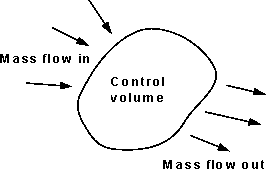[/caption]While it may offend anyone currently trying to lose that holiday weight, it is a classic physical law that in a closed system, mass can neither be created nor destroyed. Feeling discouraged yet? Well, don’t! Strictly speaking, this law does NOT mean you can’t drop pounds, just that within an isolated system (which your body is not) mass cannot be created/destroyed, although it may be rearranged in space, and changed into different types of particles. This law is known as the Conversation of Mass, otherwise known as the principal of mass/matter conservation. More specifically, the law states that the mass of an isolated system cannot be changed as a result of processes acting inside the system. This implies that for any chemical process in a closed system, the mass of the reactants must equal the mass of the products. The law is considered “classical” in that it does not take into consideration more recent physical laws, such as special relativity or quantum mechanics, but still applies in many contexts.
This law is rooted in classical Greek philosophy, which states that “nothing can come from nothing”, often stated in its Latin form: ex nihlionihlio fit. The basic premise here, first espoused by Empedocles (ca. 490–430 BCE), is that no new matter can come into existence where none was present before. It was further elaborated on by Epicurus, Parmenedes, and a number of Indian and Arab philosophers. However, it was not until the 18th century with Antoine Lavoisier that it graduated from the field of cosmology and became a scientific law. Lavoisier was the first to clearly outlined it in his seminal work TraitéÉlémentaire de Chimie (Elementary Treatise on Chemistry) in 1789.
Historically, the conservation of mass and weight was obscure for millennia because of the buoyant effect of the Earth’s atmosphere on the weight of gases. In addition, when a substance burns, mass appears to be lost since ashes weight less than the original substance. These effects were not understood until careful experiments in which chemical reactions such as rusting were performed in sealed glass ampules, whereby it was found that the chemical reaction did not change the weight of the sealed container. Once understood, the conservation of mass was of great importance in changing alchemy to modern chemistry. When chemists realized that substances never disappeared from measurement with the scales (once buoyancy effects were held constant, or had otherwise been accounted for), they could for the first time embark on quantitative studies of the transformations of substances.
The historical concept of both matter and mass conservation is widely used in many fields such as chemistry, mechanics, and fluid dynamics. In relativity, the mass-energy equivalence theorem states that mass conservation is equivalent to energy conservation, which is the first law of thermodynamics.
We have written many articles about the conservation of mass for Universe Today. Here’s an article about nuclear fusion, and here’s an article about the atom.
If you’d like more info on the law of conservation of mass, check out these articles from NASA Glenn Research Center and Engineering Toolbox.
We’ve also recorded an entire episode of Astronomy Cast all about the Atom. Listen here, Episode 164: Inside the Atom.
Sources:
http://en.wikipedia.org/wiki/Conservation_of_mass
http://www.grc.nasa.gov/WWW/K-12/airplane/mass.html
http://en.wikipedia.org/wiki/Nothing_comes_from_nothing
http://en.wikipedia.org/wiki/Antoine_Lavoisier
http://en.wikipedia.org/wiki/Jain_philosophy


